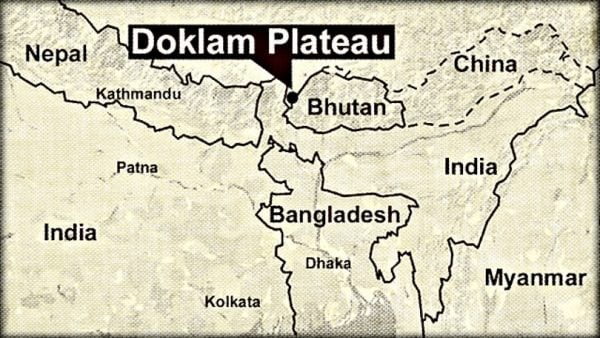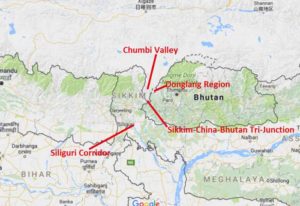
Summing up the general state of awareness in the world that we are living in, an overwhelming majority of the world seems to be either unaware of or unconcerned about the potentially catastrophic confrontation building up in the last two months in the Himalayas between India and China, the world’s two largest countries, which also happen to be the world’s second and the fourth largest economies, and, most worryingly, two nuclear armed nations that have the world’s most well-oiled defense apparatus.
The standoff, which is threatening to spiral out of control from the Chinese side, started when the one-party led Communist nation’s People’s Liberation Army (PLA) started constructing a motorable road from Dokola in the Doklam area towards the Bhutan Army camp at Zompelri on June 16, 2017.
Bhutan, which believes the area is its territory, swiftly reacted, and in a press release issued on June 29, 2017, stated clearly that “the construction of the road inside Bhutanese territory is a direct violation of its agreements with China“.
The Bhutanese foreign ministry further said:
” Boundary talks are ongoing between Bhutan and China and we have written agreements of 1988 and 1998 stating that the two sides agree to maintain peace and tranquillity in their border areas pending a final settlement on the boundary question, and to maintain status quo on the boundary as before March 1959. The agreements also state that the two sides will refrain from taking unilateral action, or use of force, to change the status quo of the boundary. Bhutan hopes that the status quo in the Doklam area will be maintained as before 16 June 2017.”
At the core of the dispute is the question of where the final tri-boundary point — the point at which India, China, and Bhutan meet — lies.
China argues that the India-China-Bhutan tri-junction is at Mount Gipmochi (Gyemo Chen), much south of Batang la, the place that India and Bhutan consider as the tri-junction. China claims 89 sq km in Doklam (along Gamochen at the border, to the river divide at Batangla and Sinchela, and down to the Amo Chhu River) as its own.
But it is one of only four areas – as per Bhutan – over which China and Bhutan, who do not have diplomatic relations, have a dispute and have had 24 rounds of talks. China, however, claims much more than that and considers a total of seven areas as disputed areas.
China, it may be noted, has territorial disputes with virtually every neighbour of its. And if its conduct in the South China Sea and with Japan over Senkaku Islands is any indication, China does not really believe in giving in to other nation’s claims.
Therefore, much before the official press release by Bhutan, and just two days after the construction work by China began, on June 18, 2017, India sent around 270 troops, with weapons and two bulldozers and stopped the Chinese troops from constructing the road.
In a 15-page document released by the Chinese Foreign Ministry on the same day, Beijing said that “over 270 Indian soldiers, carrying weapons and driving two bulldozers advanced more than 100 meters into the Chinese territory to obstruct the road building of the Chinese side, causing tension in the area.”
It further accused India of raising the number of Indian soldiers to 400.
India’s ministry of defence, however, brushed aside the Chinese accusation of escalation and said that India has been maintaining 350-400 troops at Doklam ever since the stand-off began.
The Indian action is in accordance with the India-Bhutan Treaty of Friendship of 1949, which advocated India’s guiding role in Bhutan’s diplomatic and defense affairs. Though the 1949 treaty was superseded by a new friendship treaty of 2007 that replaced the provision that made it mandatory for Bhutan to take India’s guidance on foreign policy.
The 2007 treaty provided broader sovereign rights to Bhutan by, for instance, not making it mandatory for Bhutan to take India’s permission in matters such as arms imports. But it did not alter much the inherent attached interests of the two nations.
Article 2 of the 2007 India-Bhutan Treaty says:
In keeping with the abiding ties of close friendship and cooperation between Bhutan and India, the Government of the Kingdom of Bhutan and the Government of the Republic of India shall cooperate closely with each other on issues relating to their national interests. Neither Government shall allow the use of its territory for activities harmful to the national security and interest of the other.
While sovereignty is the principal concern for Bhutan, the dispute for India beyond just the size of the territory in Doklam.

Picture Courtesy: Indian Defence Review
India is alarmed that if the Chinese do complete the motorable road in the Doklam area, it will give China an imposing access to India’s strategically vulnerable ‘chicken’s neck’ in the Siliguri Corridor, a 20km wide corridor that links India’s seven northeastern states to its mainland.
It may further be noted that Bhutan’s own administrative apparatus can get severely compromised if the Chinese inhabit Doklam as Bhutan’s communications network as it is connected through Siliguri in India.
At the moment, it is a stalemate. India is refusing to pull back its troops from the area that it says belongs to Bhutan. And China is threatening a bigger war every new day.
UPDATE:
As on August 28, 2017, India and China reached a consensus on disengagement of border personnel at the #Doklam faceoff site. A release by India’s ministry of external affairs said:
In recent weeks, India and China have maintained diplomatic communication in respect of the incident at Doklam. During these communications, we were able to express our views and convey our concerns and interests.
On this basis, expeditious disengagement of border personnel at the face-off site at Doklam has been agreed to and is on-going.
.